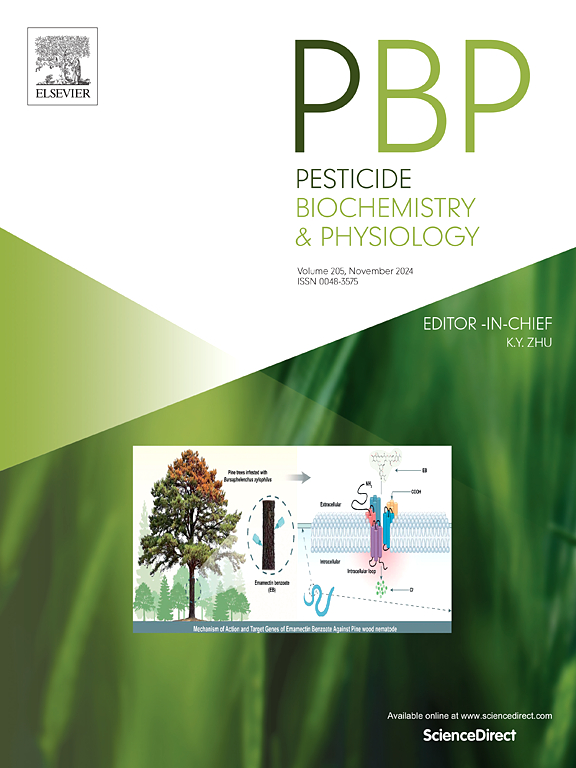Discovery of 7-hydroxy-3-(1′-methylbenzimidazol-2′-yl) coumarin as novel mitochondrial complex Ι inhibitor against Tetranychus cinnabarinus (Acari: Tetranychidae) via structure-based virtual screening
IF 4.2
1区 农林科学
Q2 BIOCHEMISTRY & MOLECULAR BIOLOGY
引用次数: 0
Abstract
Mitochondrial complex Ι is not only an important enzyme for ATP synthesis but also a promising target for acaricide discovery. However, in recent years, the complex Ι inhibitors with new scaffolds have been fewer reported. In this study, the full-length cDNA of subuits 49 kDa and PSST genes of complex Ι from Tetranychus cinnabarinus were cloned and characterized. Then, we integrated structure-based virtual screening, synthesis and acaricidal activity evaluation to discover complex Ι inhibitors with novel chemotypes. The results showed that the 49 kDa and PSST cDNA sequence of T. cinnabarinus consisted of 1443 bp and 687 bp with an open reading frame (ORF) encoding 480, 228 amino acids residues (GenBank accession number MZ172703 and MZ172704), and the highest relative expression of these two genes were nymphs and adults, respectively. The compound ZINC00042996 [7-hydroxy-3-(1′-methylbenzimidazol-2′-yl) coumarin] with highest acaricidal activity was obtained through virtual screening, its LC50 value was 84.85 mg/L, which was in the same order of magnitude as the LC50 value of pyridaben, and its control effect also could be comparable to that of the commercial acaricide pyridaben at 120 mg/L. The compound ZINC00042996 also exhibited excellent complex Ι inhibitory activity, the maximum inhibition rate was 47.03% for LC70 concentration after 48 h treatment. Knocking down the 49 kDa and PSST genes increased the sensitivity of T. cinnabarinus to compound ZINC00042996. Mortality of compound ZINC00042996 significantly increased to 29.49% and 16.47% in the mites fed with 49 kDa and PSST dsRNA compared with mites treated with DEPC-water. This study laid the foundation for the development of novel acaricides targeting mitochondrial complex Ι.

求助全文
约1分钟内获得全文
求助全文
来源期刊
CiteScore
7.00
自引率
8.50%
发文量
238
审稿时长
4.2 months
期刊介绍:
Pesticide Biochemistry and Physiology publishes original scientific articles pertaining to the mode of action of plant protection agents such as insecticides, fungicides, herbicides, and similar compounds, including nonlethal pest control agents, biosynthesis of pheromones, hormones, and plant resistance agents. Manuscripts may include a biochemical, physiological, or molecular study for an understanding of comparative toxicology or selective toxicity of both target and nontarget organisms. Particular interest will be given to studies on the molecular biology of pest control, toxicology, and pesticide resistance.
Research Areas Emphasized Include the Biochemistry and Physiology of:
• Comparative toxicity
• Mode of action
• Pathophysiology
• Plant growth regulators
• Resistance
• Other effects of pesticides on both parasites and hosts.

 求助内容:
求助内容: 应助结果提醒方式:
应助结果提醒方式:


